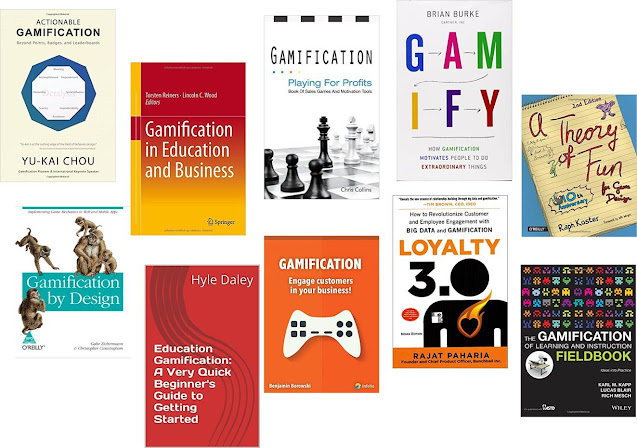Dive into the realm of Gamification with our latest article, "Explore Gamification and Top 10 Books." Uncover the power of game elements in diverse contexts and discover essential reads for designers, educators, and business enthusiasts. Join us on this engaging journey to unlock the secrets of effective game design. Some exciting books on Gamification UX, Fun theory and theory of motivation are given below for all gamification lovers.
Top Gamification UX Books
Bonus
Gamification at Work: Designing Engaging Business
Author: Janaki Mythily Kumar, Mario Herger
What is gamification? Does it belong in the workplace? Are there design best practices that can increase the efficacy of enterprise gamification efforts? Janaki Kumar and Mario Herger answer these questions and more in this book Gamification @ Work. They caution against taking a "chocolate covered broccoli" approach of simply adding points and badges to business applications and calling them gamified. They outline a methodology called Player Centered Design which is a practical guide for user experience designers, product managers and developers to incorporate the principles of gamification into their business software. Player Centered Design involves the following five steps: 1. Know your player 2. Identify the mission 3. Understand human motivation 4. Apply mechanics 5. Manage, monitor and measure Kumar and Herger provide examples of enterprise gamification, introduce legal and ethical considerations, and provide pointers to other resources to continue your journey in designing gamification that works!
1. Gamification by Design
Author: Gabe Zichermann
What do Foursquare, Zynga, Nike+ and Group on have in common?
These and many other brands use gamification to deliver a sticky, viral and
engaging experience to their customers. This book provides the design strategy
and tactics you need to integrate game mechanics into any kind of
consumer-facing website or mobile app.
2. Actionable Gamification: Beyond Points, Badges, and Leaderboards
Author: Yu-kai Chou
The new era of Gamification and Human-Focused Design
optimizes for motivation and engagement over traditional Function-Focused
Design. Within the industry, studies on game mechanics and behavioral
psychology have become proliferate. However, few people understand how to merge
the two fields into experience designs that reliably increases business metrics
and generates a return on investment.
3. Gamification in Education and Business
Author: Torsten Reiners, Lincoln Wood
This book is dedicated to applied gamification in the areas
of education and business, while also covering pitfalls to avoid and guidelines
needed to successfully implement for a project. Using different theoretical
backgrounds from various areas including behavioral economics, game theory, and
complex adaptive systems, the contributors aim to help readers avoid common
problems and difficulties that they could face with poor implementation.
4. Gamify: How Gamification Motivates People to Do Extraordinary Things
Author: Brian Burke
Buy: Gamify
Organizations are facing an engagement crisis. Regardless if
they are customers, employees, patients, students, citizens, stakeholders,
organizations struggle to meaningfully engage their key constituent groups who
have a precious and limited resource: their time. Not surprisingly, these
stakeholders have developed deflector shields to protect themselves. Only a
privileged few organizations are allowed to penetrate the shield, and even less
will meaningfully engage.
5. Education Gamification: A Quick Beginner's Guide to Getting Started
Author: Hyle Daley
Want to Gamify your classroom? This short guide will help
you understand the fundamentals of gaming and how to easily implement it into
your classroom. This guide contains information on creating rewards, badges,
and how to "Level-Up" your students. Everything is here to get you up
and running.
6. The Gamification of Learning and Instruction Fieldbook: Ideas into Practice
Author: Karl M. Kapp
Following Karl Kapp′s earlier book The Gamification of
Learning and Instruction, this Fieldbook provides a step–by–step approach to
implementing the concepts from the Gamification book with examples, tips,
tricks, and worksheets to help a learning professional or faculty member put
the ideas into practice.
7. Theory of Fun for Game Design 2nd edition
Author: Raph Kostet
Now in full color, the 10th anniversary edition of this
classic book takes you deep into the influences that underlie modern video
games, and examines the elements they share with traditional games such as
checkers. At the heart of his exploration, veteran game designer Raph Koster
takes a close look at the concept of fun and why it’s the most vital element in
any game.
8. Gamification - engage customers in your business!
Author: Benjamin Borowski
Are customers now less likely to engage fully in the life
and activity of your company? The old
myths about the power of pricing, wide product range, good selling location and
frequent promotion aren't pulling in as much profit as before. Average
customers are no longer responding to "total sale" or "new
product launch" or "available everywhere". They are fed up with
that. They become fussier.
9. Gamification: Playing For Profits: A Book of Sales Games and Motivational Tools
Author: Chris Collins
This book is your hack to creating the fun and challenging
workplace essential to inspiring your employees to work harder and better
together, as your business gains momentum, increases profits, and shows
improved overall morale starting tomorrow.
10. Loyalty 3.0: How to Revolutionize Customer and Employee Engagement with Big Data and Gamification
Author: Rajat Paharia
Buy: Loyalty3.0
Once revolutionary, loyalty programs designed to
differentiate products quickly became commoditized and yet, billions of dollars
are still spent every year on programs that are doomed to fail. These programs,
it turns out, don't inspire long-term loyalty. Once a better deal comes along,
customers will gladly defect.
Learn more about Gamification >>
Learn more about Gamification >>



















%20in%20India.png)

